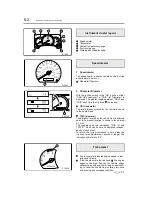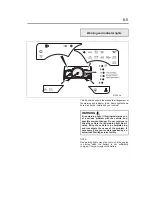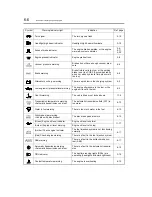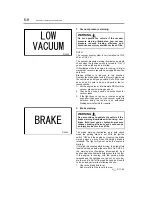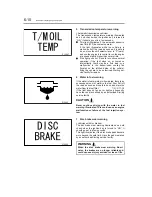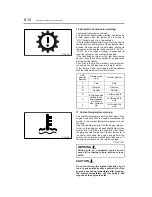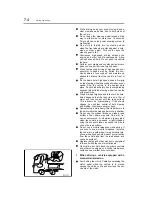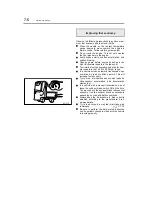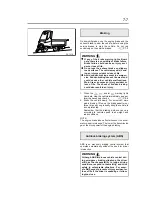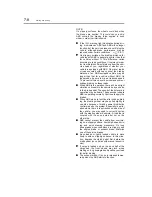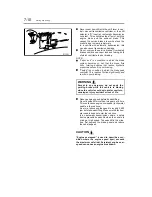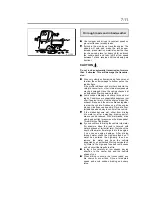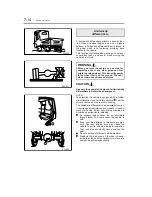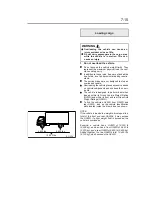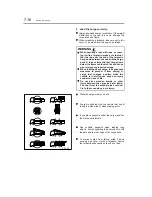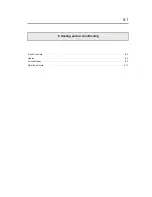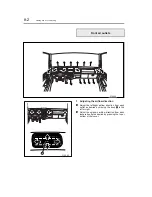
7-4
Starting and driving
•
While driving, keep your eyes moving. Keep a
clear view ahead, behind, and to both sides of
the vehicle.
•
Do not keep the steering wheel turned all the
way to either side for more than 10 seconds.
This could cause the power steering system to
malfunction.
•
Do not try to forcibly turn the steering wheel
when the front wheels are stuck against a curb-
stone or other object. This could cause the
steering gear to fail.
•
Continuous high-speed driving burdens the
engine and other vehicle components. Allow
yourself enough time. Do not push the vehicle
too hard.
•
Perform your pretrip checks with particular care
when you expect to drive at high speeds.
•
When continuously driving at high speeds, your
sensitivity to speed may be dulled. Be con-
stantly aware of your speed, and maintain an
adequate distance from the vehicle in front of
you.
•
If a tire blows out at high speed, keep a firm grip
on the steering wheel and gradually reduce your
speed. Stop the vehicle in the nearest safe
place. Do not brake sharply. Avoid sharp braking
because this pulls the steering wheel to one side
with great force.
•
When driving at high speeds in the rain, it some-
times happens that the tires ride on a film of
water and lose contact with the road surface.
This is known as “hydroplaning.” If this should
happen, you will lose control of both steering
and braking. Slow down on rainy days.
•
Hydroplaning is more likely if tire tread is worn to
the point where the tread pattern is very shallow.
•
Do not use the exhaust brake on slippery road
surfaces. The vehicle may skid. On a wet, fro-
zen, snow-covered, or otherwise slippery road,
when the vehicle is unloaded or lightly loaded,
using the exhaust brake can cause the tires to
slip on the road surface.
•
Do not use a mobile telephone while driving. If
you wish to use a mobile telephone, first stop
the vehicle in a safe place. Using a mobile tele-
phone while driving could distract your attention
from the vehicle and from the road ahead, and
cause an accident.
•
Operate radios and other electronic equipment
in the cab while the vehicle is stationary.
•
Do not allow a child to touch the driver’s controls
and other cab equipment. A child’s interference
could cause a malfunction or accident.
1 When driving a vehicle equipped with a
manual transmission
•
Avoid riding the clutch. Partially depressing the
clutch pedal while the vehicle is in motion
causes the clutch to slip and shortens the ser-
vice life of the clutch.
Z11317
Содержание 360
Страница 13: ...2 1 Locations in cab 2 2 Locations outside cab 2 4 2 Warning labels ...
Страница 16: ...2 4 Warning labels Locations outside cab Z12496 ...
Страница 19: ...2 7 Warning labels 30 gallon 113 liter fuel tank Z12494 ...
Страница 20: ...3 1 Doors 3 2 Master door locks 3 4 Entering and exiting the vehicle 3 5 Door window 3 6 3 Vehicle access ...
Страница 27: ...4 1 Seats 4 2 Seat belts 4 4 Steering wheel 4 7 4 Seat and steering wheel adjustments ...
Страница 104: ...10 1 Coolant 10 2 Engine oil 10 2 Fuels 10 2 Cold weather operation 10 3 Installing tire chains 10 4 10 In cold weather ...
Страница 200: ...13 1 Recommended lubricants hydraulic fluids and quantities 13 2 Service specifications 13 4 13 Service data ...
Страница 204: ...14 1 Maintenance schedule 14 2 Lubrication schedule 14 6 14 Maintenance schedule ...
Страница 210: ...15 1 15 Alphabetical index ...

